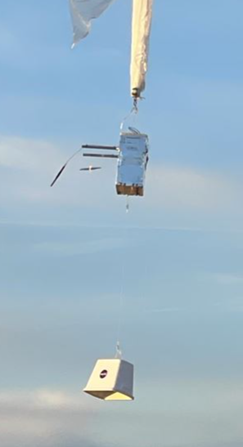Raven Aerostar's stratospheric lighter-than-air platforms have helped NASA, Google, and many other customers achieve and exceed dynamic missions, including communications, data relay, surveillance, intelligence, and more. A large part of this success involves integrating unique technology with our balloons in the form of a payload. But how are these complex connections made? Here's a behind-the-scenes look at payload integrations.

Sara Venhuizen, Systems Engineering Team Lead for Raven Aerostar's payload integrations team, sat down with us to discuss payload integrations. Our payload integrations team is made up of five people that are a mix of mechanical engineers, electrical engineers, and technicians. The team's creativity and dedication to serving our customers ensures that their stratospheric balloon systems work seamlessly, solving great challenges in aerospace and defense.

What are Payloads?
When our stratospheric balloons fly, they fly with a purpose — to carry payloads. Payloads are containers that hold technology or items. Raven Aerostar works with a few different kinds of payloads:
- Scientific Payloads: Carry out an experiment (NASA nephelometer).
- Commercial Payloads: Carry out a service (Project Loon, an Alphabet, Inc. subsidiary, offered 4G and 5G cell service).
- Communications Payloads: Carry radios to extend communications range (Department of Defense).
- ISR Payloads: Carry intelligence, surveillance, and reconnaissance sensors (Department of Defense).
What is Payload Integration?
Through different programs, customers approach Raven to fly their payloads for many different reasons. The customer can either work with our balloon specifications and technology to figure out how to attach the payload and power it themselves, or have our team integrate their payload on their behalf.
Integrating the payloads to the stratospheric balloon is complex and multidimensional. The team works to connect the payload both electrically and mechanically. Our system has batteries and solar panels that provide electricity to the payloads, and electrical integration involves connecting to and sometimes converting power rails. Mechanically integrating the payload involves attaching it to the balloon system, keeping its contents safe during the launch, flight, and landing.
A critical obstacle for stratospheric balloon flights are the extreme weather conditions. The air temperature in the stratosphere can go from -25°C (-13°F) to -80°C (-112°F). However, even at cold temperatures, high-power payloads can have trouble with heat, and traditional methods like fans don’t work in the extremely low pressures. Some payloads freeze, and some payloads overheat. To test the payload’s ability to withstand those temperatures and pressures, the team uses a thermal chamber. The thermal chamber tests are extensive — payloads can break or fail the test several times before they are ready for the flight. To help payloads survive, the integrations team can provide heaters and heater control, or a special frame designed to pull heat away from high-power payloads.
Real-Time Payload Information
In addition to their technical support, the Raven Aerostar team offers a service for customers to access real-time information about their payload during flight. The team can install a radio kit that provides a communication path from the payload to a ground location. The integration team works with the customer to teach them how to access their secure portal and support the specific data rates that are most useful for the customers’ payload purpose.
